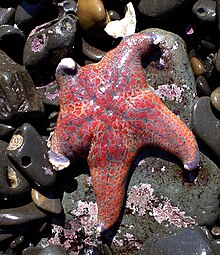Sea star wasting disease
Starfish wasting disease is a disease of starfish that appears sporadically, causing mass mortality of affected starfish. The disease is little understood but seems to be associated with raised water temperatures.

Symptoms
The first symptom of starfish wasting disease is white lesions that appear on the surface of the starfish and spread rapidly. Next the animal becomes limp as the water vascular system fails and it is no longer able to maintain its internal hydrostatic balance. The body structure begins to break down, signs of stretching appear between the arms which may twist and fall off, and the animal dies. The arms may continue to crawl around for a while after being shed. All these events happens within the course of a few days.[1]
1972 plague
A die-off of large numbers of common starfish (Asterias rubens) occurred in 1972 off the United States east coast. The starfish concerned became limp and started falling to pieces.[2]
1978 plague
In 1978 large numbers of the predatory starfish Heliaster kubiniji succumbed to a wasting disease in the Gulf of California. At the time it was suspected that high water temperatures were a causal factor. This starfish became locally extinct in some parts of the gulf and some populations had still not recovered by the year 2000. Because this starfish is a top-level predator, its disappearance had profound effects on the ecosystem.[3] In the Channel Islands off the coast of California, ten species of starfish were recorded as being affected as well as three species of sea urchins, two brittle stars and a sea cucumber, all of which experienced large population declines.[4]
2013 plagues
In July 2013, populations of starfish declined rapidly on the east coast of the United States between New Jersey and Maine. There had been a great increase in starfish numbers three years earlier and now they were dying off. No cause for the mysterious deaths was apparent.[5]
At the beginning of September 2013, a mass die-off of starfish was reported off the coast of British Columbia. The sea bed was littered with disintegrating sunflower stars (Pycnopodia helianthoides), their detached arms and discs. Another species also suffering mortalities was the morning sun star (Solaster dawsoni) but no cause for the deaths was apparent. If they were caused by infection or toxins, the two species might have affected each other because the diet of each includes starfish.[6]
In October 2013, in a marine laboratory seawater tank in California holding various species of starfish, other species started displaying similar symptoms. The ochre star (Pisaster ochraceus) was the first affected. Most of these developed symptoms, lost arms and died over the course of a week or so. Later the rainbow star (Orthasterias koehleri) developed the disease and died, but the bat star (Patiria miniata) and leather star (Dermasterias imbricata), which were living in the same tank and had been scavenging on the corpses, showed no ill effects.[1] At Natural Bridges State Marine Reserve in California, the ochre star is normally a very common resident on the mussel beds, but in November 2013 it was reported to have completely disappeared.[1]
Causes
So far (November 2013) no identifiable cause for the disease has been found. Pathogenic bacteria do not seem to be present, and though the plague might be caused by a viral or fungal pathogen, no causal agent has been found. Each episode of plague might have a different cause.[2]
Other possible causes of the condition that have been suggested include high sea temperatures, oxygen depletion and low salinity due to freshwater runoff, but none of these theories seem very convincing. Research suggests that high water temperatures are indeed linked to the disease, increasing its incidence and virulence. The disease also seems more prevalent in sheltered waters than in open seas with much wave movement. One result of global warming is likely to be higher sea temperatures. These may impact both on starfish and on echinoderm populations in general, and a ciliate protozoan parasite (Orchitophrya stellarum) of starfish, which eats sperm and effectively emasculates male starfish, thrives at higher temperatures.[7]
References
- ^ a b c Gong, Allison J. (2013-09-07). "A plague of stars". Notes from a California naturalist. Retrieved 2013-11-17.
- ^ a b Mah, Christopher (2013-09-10). "Starfish Wasting Disease!". Echinoblog. Retrieved 2013-11-17.
- ^ Dungan, Michael L.; Miller, Thomas E.; Thomson, Donald A. (1982). "Catastrophic Decline of a Top Carnivore in the Gulf of California Rocky Intertidal Zone". Science. 216 (4549): 989–991. doi:10.1126/science.216.4549.989.
{{cite journal}}: CS1 maint: multiple names: authors list (link) - ^ Eckert, Ginny L.; Engle, John M.; Kushner, David J. (2000). "Sea star disease and population declines at the Channel Islands" (PDF). Proceedings of the Fifth California Islands Symposium. Minerals Management Service 99-0038: 390–393.
{{cite journal}}: CS1 maint: multiple names: authors list (link) - ^ Laine, Martin (2013-07-24). "Massive east coast starfish die-off reported". Science. Retrieved 2013-11-17.
- ^ Mah, Christopher (2013-09-03). "Mysterious Mass Sunflower Starfish (Pycnopodia) Die-off in British Columbia". Echinoblog. Retrieved 2013-11-17.
- ^ Mah, Christopher (2010-07-20). "Another Worry From Global Warming: Parasites that eat Starfish Sperm". Echinoblog. Retrieved 2013-11-17.
